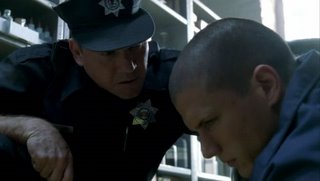How Mulvey’s theory could be useful for me in my Independent Study
Although “Prison Break” is very largely male dominated, therefore doubting the use of Mulvey’s theory: male gaze, there are two particular female characters that can be seen as playing a large part in the application of “Prison Break” with the feminist theory.
One of the two main female characters is the Prison Doctor: Sara Tancredi who plays the role (in Proppian terms) of the princess. Therefore, this passive female already conforms to Mulvey’s theory of the audience watching her voyeuristically. This is because the doctor would provide the audience, who are put in a male position, with erotic pleasure but she is always dressed fully with her white cloak. This suggests that the audience are unable to fetishize her body. The story of Michael Scofield liking the doctor could reinforce voyeurism by the spectator. She may also be objectified because she is the only main actress in the first series. Therefore, because of the nature of the character Dr Tancredi and her relationship with Michael Scofield, Mulvey’s theory of the male gaze can be applied to the drama series mainly because of the voyeuristic pleasure experienced by the audience.
Similarly, Veronica Donovan is an attractive woman and possesses the quality of to-be-looked-at-ness. The male audience are able to objectify her and unlike Dr Tancredi, fetishize her body. Mulvey’s idea of scopophilia, taken from Freud, can be applied to this character because the male audience would take pleasure in looking at her on screen voyeuristically. A scene where this would be especially apparent is when Lincoln reminisces back to the moment of himself and Veronica in bed together. However, she plays a lawyer in the drama and so is not very passive but does go under the charm of a male who tries to kill her. This shows that there is a sense of patriarchy in “Prison Break” through the fact that the males play the active roles but in terms of a male audience, it can be noted that the lack of women represented in the drama give doubt to the theory of the male gaze from the spectator.
There is also use of the phallic object in “Prison Break”. Again, this involves the doctor as she uses a syringe to inject medicine into Scofield for his diabetes weekly. This implies the male castration taking place because the actress is holding it. Additionally, there are numerous knives and screw-drivers used in the series and can be interpreted as phallic symbols, conforming to Mulvey’s theory.
Therefore, some of Mulvey’s theories such a masochism and narcissism are not apparent in “Prison Break” purely because of the scale of male dominance in the drama series. On the other hand, the two actresses that play important roles allow the male gaze; voyeurism and fetishism to be apparent signified through interaction with the male characters. Similarly, phallic symbols are numerously used in the series from guns to syringes to pens.

(taken from Prison Break's fan website- screen caps)
Although “Prison Break” is very largely male dominated, therefore doubting the use of Mulvey’s theory: male gaze, there are two particular female characters that can be seen as playing a large part in the application of “Prison Break” with the feminist theory.
One of the two main female characters is the Prison Doctor: Sara Tancredi who plays the role (in Proppian terms) of the princess. Therefore, this passive female already conforms to Mulvey’s theory of the audience watching her voyeuristically. This is because the doctor would provide the audience, who are put in a male position, with erotic pleasure but she is always dressed fully with her white cloak. This suggests that the audience are unable to fetishize her body. The story of Michael Scofield liking the doctor could reinforce voyeurism by the spectator. She may also be objectified because she is the only main actress in the first series. Therefore, because of the nature of the character Dr Tancredi and her relationship with Michael Scofield, Mulvey’s theory of the male gaze can be applied to the drama series mainly because of the voyeuristic pleasure experienced by the audience.
Similarly, Veronica Donovan is an attractive woman and possesses the quality of to-be-looked-at-ness. The male audience are able to objectify her and unlike Dr Tancredi, fetishize her body. Mulvey’s idea of scopophilia, taken from Freud, can be applied to this character because the male audience would take pleasure in looking at her on screen voyeuristically. A scene where this would be especially apparent is when Lincoln reminisces back to the moment of himself and Veronica in bed together. However, she plays a lawyer in the drama and so is not very passive but does go under the charm of a male who tries to kill her. This shows that there is a sense of patriarchy in “Prison Break” through the fact that the males play the active roles but in terms of a male audience, it can be noted that the lack of women represented in the drama give doubt to the theory of the male gaze from the spectator.
There is also use of the phallic object in “Prison Break”. Again, this involves the doctor as she uses a syringe to inject medicine into Scofield for his diabetes weekly. This implies the male castration taking place because the actress is holding it. Additionally, there are numerous knives and screw-drivers used in the series and can be interpreted as phallic symbols, conforming to Mulvey’s theory.
Therefore, some of Mulvey’s theories such a masochism and narcissism are not apparent in “Prison Break” purely because of the scale of male dominance in the drama series. On the other hand, the two actresses that play important roles allow the male gaze; voyeurism and fetishism to be apparent signified through interaction with the male characters. Similarly, phallic symbols are numerously used in the series from guns to syringes to pens.

(taken from Prison Break's fan website- screen caps)

